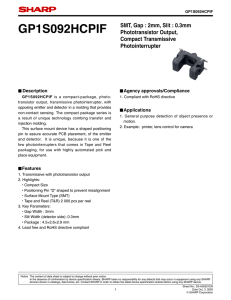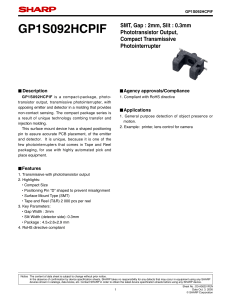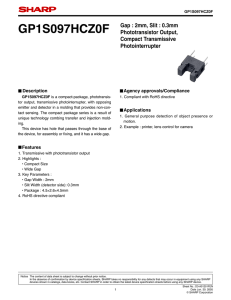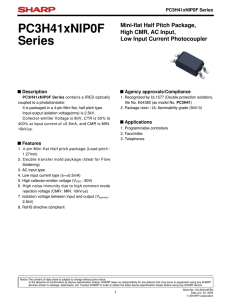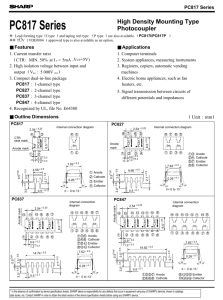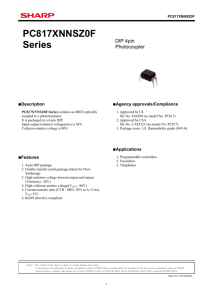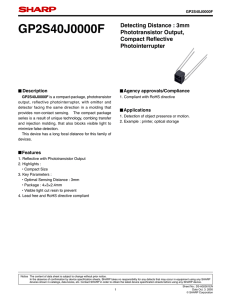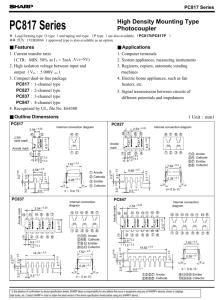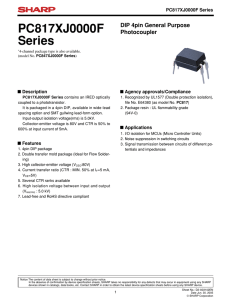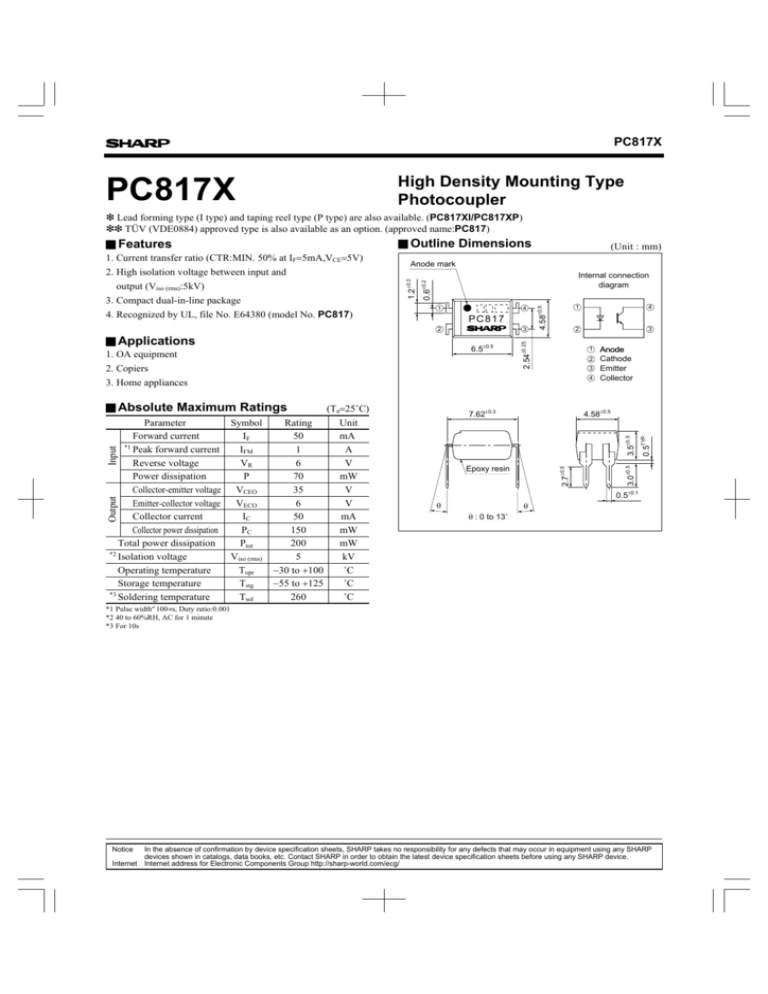
PC817X
High Density Mounting Type
Photocoupler
PC817X
❇ Lead forming type (I type) and taping reel type (P type) are also available. (PC817XI/PC817XP)
❇❇ TÜV (VDE0884) approved type is also available as an option. (approved name:PC817)
■ Outline Dimensions
Anode mark
Internal connection
diagram
4
PC817
2
3
1
2
3
7.62±0.3
4.58±0.5
3.5±0.5
(Ta=25˚C)
Unit
mA
A
V
mW
V
V
mA
mW
mW
kV
˚C
˚C
˚C
Anode
Cathode
Emitter
Collector
Epoxy resin
3.0±0.5
Rating
50
1
6
70
35
6
50
150
200
5
−30 to +100
−55 to +125
260
2.7±0.5
Input
4
4
■ Absolute Maximum Ratings
Output
1
0.5TYP.
6.5
1. OA equipment
2. Copiers
3. Home appliances
±0.5
2.54±0.25
3
2
4.58±0.5
1
■ Applications
Parameter
Symbol
IF
Forward current
*1
Peak forward current
IFM
Reverse voltage
VR
Power dissipation
P
Collector-emitter voltage VCEO
Emitter-collector voltage VECO
Collector current
IC
Collector power dissipation
PC
Total power dissipation
Ptot
*2
Isolation voltage
Viso (rms)
Operating temperature
Topr
Storage temperature
Tstg
*3
Soldering temperature
Tsol
(Unit : mm)
0.6±0.2
1. Current transfer ratio (CTR:MIN. 50% at IF=5mA,VCE=5V)
2. High isolation voltage between input and
output (Viso (rms):5kV)
3. Compact dual-in-line package
4. Recognized by UL, file No. E64380 (model No. PC817)
1.2±0.3
■ Features
0.5±0.1
θ
θ
θ : 0 to 13˚
*1 Pulse width≤100µs, Duty ratio:0.001
*2 40 to 60%RH, AC for 1 minute
*3 For 10s
Notice
In the absence of confirmation by device specification sheets, SHARP takes no responsibility for any defects that may occur in equipment using any SHARP
devices shown in catalogs, data books, etc. Contact SHARP in order to obtain the latest device specification sheets before using any SHARP device.
Internet Internet address for Electronic Components Group http://sharp-world.com/ecg/
PC817X
■ Electro-optical Characteristics
Input
Output
Transfer
characteristics
Parameter
Forward voltage
Peak forward voltage
Reverse current
Terminal capacitance
Collector dark current
Collector current
Collector-emitter saturation voltage
Isolation resistance
Floating capacitance
Cut-off frequency
Rise time
Response time
Fall time
■ Rank Table
Model No.
PC817X
PC817X1
PC817X2
PC817X3
PC817X4
PC817X5
PC817X6
PC817X7
PC817X8
PC817X9
PC817X0
Symbol
VF
VFM
IR
Ct
ICEO
IC
VCE (sat)
RISO
Cf
fc
tr
tf
Conditions
IF=20mA
IFM=0.5V
VR=4V
V=0, f=1kHz
VCE=20V, IF=0
IF=5mA, VCE=5V
IF=20mA, IC=1mA
DC500V, 40 to 60%RH
V=0, f=1MHz
VCE=5V, IC=2mA, RL=100Ω, −3dB
VCE=2V, IC=2mA, RL=100Ω
(Ta=25˚C)
Unit
V
V
µA
pF
nA
mA
V
Ω
pF
kHz
µs
µs
Fig.2 Collector Power Dissipation vs.
Ambient Temperature
200
Collector power dissipation PC (mW)
60
50
Forward current IF (mA)
MAX.
1.4
3.0
10
250
100
30.0
0.2
−
1.0
−
18
18
(IF=5mA, VCE=5V, Ta=25˚C)
IC (mA)
Rank mark
A, B, C, D or no mark
2.5 to 30.0
A
4.0 to 8.0
6.5 to 13.0
B
10.0 to 20.0
C
15.0 to 30.0
D
4.0 to 13.0
A or B
B or C
6.5 to 20.0
C or D
10.0 to 30.0
A, B or C
4.0 to 20.0
B, C or D
6.5 to 30.0
A, B, C or D
4.0 to 30.0
Fig.1 Forward Current vs. Ambient
Temperature
40
30
20
10
0
−30
TYP.
1.2
−
−
30
−
−
0.1
1011
0.6
80
4
3
MIN.
−
−
−
−
−
2.5
−
5×1010
−
−
−
−
0
25
50
75
Ambient temperature Ta (˚C)
100
125
150
100
50
0
−30
0
25
50
75
Ambient temperature Ta (˚C)
100
125
PC817X
Fig.3 Peak Forward Current vs. Duty Ratio
Fig.4 Current Transfer Ratio vs. Forward
Current
10 000
200
Pulse width≤100µs
Ta=25˚C
2 000
1 000
500
200
100
50
20
10
5
VCE=5V
Ta=25˚C
180
Current transfer ratio CTR (%)
Peak forward current IFM (mA)
5 000
160
140
120
100
80
60
40
20
5 10−3 2
5 10−2 2
0
5 10−1 2
5
2
1
1
5
20
50
Forward current IF (mA)
Duty ratio
Fig.5 Forward Current vs. Forward Voltage
Fig.6 Collector Current vs. Collector-emitter
Voltage
30
500
Ta=75˚C
IF=30mA
50˚C
100
25˚C
0˚C
50
−25˚C
25
Collector current IC (mA)
200
Forward current IF (mA)
10
20
10
5
Ta=25˚C
20mA
PC (MAX.)
20
15
10mA
10
5mA
2
5
1
0
0
0.5
1.0
1.5
2.0
2.5
3.0
0
3.5
Fig.7 Relative Current Transfer Ratio vs.
Ambient Temperature
3
4
5
6
100
50
0
25
50
Ambient temperature Ta (˚C)
75
100
Collector-emitter saturation voltage VCE (sat) (V)
0.16
IF=5mA
VCE=5V
Relative current transfer ratio (%)
2
7
8
9
Fig.8 Collector - emitter Saturation Voltage
vs. Ambient Temperature
150
0
−30
1
Collector-emitter voltage VCE (V)
Forward voltage VF (V)
IF=20mA
IC=1mA
0.14
0.12
0.10
0.08
0.06
0.04
0.02
0
−25
0
25
50
75
Ambient temperature Ta (˚C)
100
PC817X
Fig.9 Collector Dark Current vs. Ambient
Temperature
6
VCE=20V
Collector-emitter saturation voltage VCE (sat) (V)
10−5
Fig.10 Collector-emitter Saturation Voltage
vs. Forward Current
Collector dark current ICEO (A)
10−6
10−7
10−8
10−9
10−10
10−11
−25
Ta=25˚C
IC=0.5mA
5
1mA
4
3mA
5mA
3
7mA
2
1
0
0
25
50
75
0
100
5
Ambient temperature Ta (˚C)
Fig.11 Response Time vs. Load Resistance
500
200
100
15
Test Circuit for Response Time
VCE=2V
IC=2mA
Ta=25˚C
Input
VCC
Output
50
Response time (µs)
10
Forward current IF (mA)
Input
tr
20
10
RD
RL
10%
Output
tf
90%
ts
td
tr
5
tf
td
2
1
ts
0.5
0.2
0.1
0.1
1
10
Load resistance RL (kΩ)
Test Circuit for Frequency Response
Fig.12 Frequency Response
VCE=2V
IC=2mA
Ta=25˚C
Voltage gain Av (dB)
0
100Ω
1kΩ
−10
RL=10kΩ
−20
0.5
1
2
5
10
20
50 100 200 500
Frequency f (kHz)
VCC
RD
RL
Output
NOTICE
●
The circuit application examples in this publication are provided to explain representative applications of SHARP
devices and are not intended to guarantee any circuit design or license any intellectual property rights. SHARP takes
no responsibility for any problems related to any intellectual property right of a third party resulting from the use of
SHARP's devices.
●
Contact SHARP in order to obtain the latest device specification sheets before using any SHARP device. SHARP
reserves the right to make changes in the specifications, characteristics, data, materials, structure, and other contents
described herein at any time without notice in order to improve design or reliability. Manufacturing locations are
also subject to change without notice.
●
Observe the following points when using any devices in this publication. SHARP takes no responsibility for damage
caused by improper use of the devices which does not meet the conditions and absolute maximum ratings to be used
specified in the relevant specification sheet nor meet the following conditions:
(i) The devices in this publication are designed for use in general electronic equipment designs such as:
- - - Personal computers
- -- Office automation equipment
- -- Telecommunication equipment [terminal]
- - - Test and measurement equipment
- - - Industrial control
- -- Audio visual equipment
- -- Consumer electronics
(ii) Measures such as fail-safe function and redundant design should be taken to ensure reliability and safety when
SHARP devices are used for or in connection with equipment that requires higher reliability such as:
- -- Transportation control and safety equipment (i.e., aircraft, trains, automobiles, etc.)
- - - Traffic signals
- - - Gas leakage sensor breakers
- - - Alarm equipment
- -- Various safety devices, etc.
(iii)SHARP devices shall not be used for or in connection with equipment that requires an extremely high level of
reliability and safety such as:
- - - Space applications
- -- Telecommunication equipment [trunk lines]
- -- Nuclear power control equipment
- -- Medical and other life support equipment (e.g., scuba).
●
If the SHARP devices listed in this publication fall within the scope of strategic products described in the Foreign
Exchange and Foreign Trade Law of Japan, it is necessary to obtain approval to export such SHARP devices.
●
This publication is the proprietary product of SHARP and is copyrighted, with all rights reserved. Under the copyright
laws, no part of this publication may be reproduced or transmitted in any form or by any means, electronic or
mechanical, for any purpose, in whole or in part, without the express written permission of SHARP. Express written
permission is also required before any use of this publication may be made by a third party.
●
Contact and consult with a SHARP representative if there are any questions about the contents of this publication.

